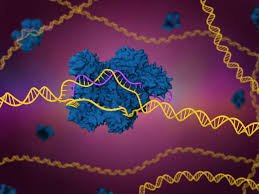"CRISPR Technology: The Key to Eradicating Genetic Diseases?"

CRISPR technology has emerged as one of the most promising tools in modern medicine, offering the potential to revolutionize the treatment and eradication of genetic diseases. CRISPR, which stands for “Clustered Regularly Interspaced Short Palindromic Repeats,” is a groundbreaking gene-editing technique that allows scientists to precisely alter DNA within living organisms. By enabling the targeted modification of genes, CRISPR opens new possibilities for curing genetic disorders that were once considered incurable, bringing hope to millions of people affected by hereditary diseases.
At its core, CRISPR operates like molecular scissors, enabling researchers to cut, add, or replace specific sections of DNA with remarkable precision. This is accomplished with the help of a protein called Cas9, which acts as a guide to locate and cut the DNA at the exact spot where modification is needed. Once the DNA is cut, the cell's natural repair mechanisms can be harnessed to correct the genetic defect, effectively eliminating the cause of many inherited diseases.
The potential of CRISPR to eradicate genetic diseases is especially promising for conditions caused by single-gene mutations. Diseases such as cystic fibrosis, sickle cell anemia, and Duchenne muscular dystrophy, which are caused by specific genetic errors, could potentially be treated by directly editing the faulty genes responsible for these conditions. In fact, CRISPR has already shown success in clinical trials aimed at treating sickle cell anemia and beta-thalassemia, blood disorders caused by mutations in the hemoglobin gene. By editing the DNA of patients’ stem cells, researchers have been able to reprogram their bodies to produce healthy red blood cells, providing a potential cure for these debilitating conditions.
Beyond these initial successes, CRISPR holds the potential to address a wide range of genetic diseases. For example, researchers are exploring ways to use CRISPR to treat inherited eye diseases like Leber congenital amaurosis, which causes blindness, and genetic disorders of the immune system, such as severe combined immunodeficiency (SCID). Additionally, CRISPR may play a crucial role in the fight against certain types of cancer by enabling the precise modification of immune cells to target and destroy cancerous cells.
Despite the enormous promise, the widespread use of CRISPR in human medicine still faces challenges. One of the primary concerns is ensuring the safety and accuracy of gene editing. While CRISPR has shown great promise in the lab, there are still risks associated with unintended genetic changes, which could potentially lead to harmful side effects or unforeseen consequences. Researchers are working to improve the precision of CRISPR and reduce the risk of off-target effects, but further studies and clinical trials are needed to fully understand the long-term implications of genetic editing.
Ethical considerations also play a significant role in the debate surrounding CRISPR technology. While gene editing has the potential to eliminate hereditary diseases, it also raises questions about its use in editing the human germline—the DNA passed on to future generations. This could lead to concerns about “designer babies” or the modification of traits unrelated to disease, such as intelligence or physical appearance. As a result, scientists, ethicists, and policymakers must work together to establish guidelines and regulations for the responsible use of CRISPR technology.